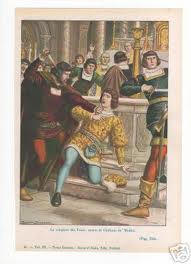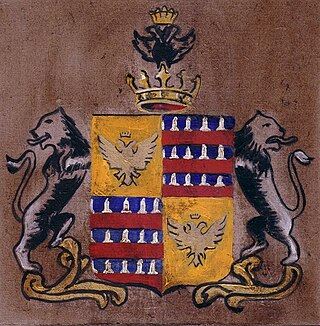Renato di Piero de' Pazzi (6 September 1442 - April 1478) was an Italian politician and banker by Republic of Florence, who died in the riots that followed the failure of the Pazzi conspiracy against the Medici family.

Renato di Piero de' Pazzi (6 September 1442 - April 1478) was an Italian politician and banker by Republic of Florence, who died in the riots that followed the failure of the Pazzi conspiracy against the Medici family.

Renato de' Pazzi was born on 6 September 1442 in the Republic of Florence. He was a member of Pazzi family, one of seven children of Piero de' Pazzi and grandson of Andrea de' Pazzi. His uncles were Jacopo and Antonio de' Pazzi, and his cousins Guglielmo and Francesco de' Pazzi (sons of Antonio). [1] [2] He was baptized in the presence of René of Anjou, a close friend of his grandfather, and named in his honour. [1]
In 1463 he married Francesca Martini, with whom he had eight children, [2] and held some modest positions in the city government such as Member of the VIII di Balia e Guardia (1473) and mint officer (1476). [3]
In 1478 he learned of plans by his uncle Jacopo and his cousin Francesco to eliminate the brothers Lorenzo and Giuliano de' Medici, governors de facto of the city of Florence. Renato was against and did not take part in the conspiracy and, when it failed on 26 April 1478, he tried to flee from Florence, but failed and few days after he was captured, lynched and finally hanged at windows of the Palazzo della Signoria from the crowd of Medici supporters. [2] [3]

Lorenzo di Piero de' Medici, known as Lorenzo the Magnificent, was an Italian statesman, banker, de facto ruler of the Florentine Republic, and the most powerful and enthusiastic patron of Renaissance culture in Italy. He was a magnate, diplomat, politician and patron of scholars, artists, and poets. As a patron, he is best known for his sponsorship of artists such as Botticelli and Michelangelo. He held the balance of power within the Italic League, an alliance of states that stabilized political conditions on the Italian peninsula for decades, and his life coincided with the mature phase of the Italian Renaissance and the Golden Age of Florence. On the foreign policy front, Lorenzo manifested a clear plan to stem the territorial ambitions of Pope Sixtus IV, in the name of the balance of the Italian League of 1454. For these reasons, Lorenzo was the subject of the Pazzi conspiracy (1478), in which his brother Giuliano was assassinated. The Peace of Lodi of 1454 that he supported among the various Italian states collapsed with his death. He is buried in the Medici Chapel in Florence.

The Pazzi were a powerful family in the Republic of Florence. Their main trade during the fifteenth century was banking. In the aftermath of the Pazzi conspiracy in 1478, members of the family were banished from Florence and their property was confiscated; the family name and coat-of-arms were permanently suppressed by order of the Signoria.

Giuliano de' Medici was the second son of Piero de' Medici and Lucrezia Tornabuoni. As co-ruler of Florence, with his brother Lorenzo the Magnificent, he complemented his brother's image as the "patron of the arts" with his own image as the handsome, sporting "golden boy." He was killed in a plot known as the Pazzi conspiracy.

The Pazzi conspiracy was a failed plot by members of the Pazzi family and others to displace the Medici family as rulers of Renaissance Florence.

Francesco de' Pazzi was a Florentine banker, a member of the Pazzi noble family, and one of the instigators of the Pazzi conspiracy, a plot to displace the Medici family as rulers of the Florentine Republic. His uncle, Jacopo de' Pazzi, was one of the main organizers of the conspiracy.

The Salviati family is an historical family, rooted in the Republic of Florence.

Jacopo III Appiano, VI Lord of Piombino was an Italian nobleman.

The palleschi, also known as bigi, were partisans of the Medici family in Florence. The name derived by the Medici coat-of-arms, bearing six 'balls' (palle).

The Gherardini of Montagliari was one of the most prominent historical Italian noble families from Tuscany, Italy. Through the Amideis, the family was of Roman descent. Between the 9th and 14th centuries, they played an important role in Tuscany. Its influence was also felt in the Veneto and Emilia regions between the 16th and 18th centuries, and during the Italian Risorgimento as well as in today's Italian politics and economy. The family’s restless and fighting nature has aroused the curiosity of many historians of the Middle Ages. Originating from feudal tradition, it was one of the founding families of the Republic of Florence.
Bianca Maria di Piero de' Medici was a member of the de' Medici family, de facto rulers of Florence in the late 15th century. She was the daughter of Piero di Cosimo de' Medici, de facto ruler of the Florentine Republic, and sister of Lorenzo de' Medici, who succeeded his father in that position. She married Guglielmo de' Pazzi, a member of the Pazzi family. She was a musician, and played the organ for Pope Pius II and the future Pope Alexander VI in 1460; she was a landowner.
Bernardo Bandini Baroncelli was an Florentine merchant and a protagonist in the Pazzi conspiracy, a plot to remove the Medici family from power in Florence.

Jacopo de' Pazzi was a Florentine banker who became head of the Pazzi family in 1464, and the younger child of Andrea de' Pazzi and Costanza de' Bardi. He commissioned Palazzo Pazzi between 1462 and 1472. Stefano di Ser Niccolo da Bagnone served as a secretary to Jacopo and tutor to his daughter Caterina. He was killed alongside his nephews Francesco and Renato after the failed Pazzi conspiracy, which was a plot to remove the Medici family from power in Florence.

Ormanno di Rinaldo degli Albizzi was an Italian ambassador and military, firstborn of Rinaldo degli Albizzi and his wife Alessandra de' Ricco.

Andrea di Guglielmo de' Pazzi was an Italian politician of Republic of Florence, known for having commissioned the Pazzi Chapel from Filippo Brunelleschi and for being the father of Jacopo de' Pazzi and the grandfather of Francesco and Guglielmo de' Pazzi.

Guglielmo di Antonio de' Pazzi, Lord of Civitella was an Italian nobleman, banker and politician from the Republic of Florence. He was also husband of Bianca de' Medici, sister of the Lord of Florence Lorenzo the Magnificent.

Caterina di Jacopo de' Pazzi was an Italian blessed, and daughter of Jacopo de' Pazzi, creator of the Pazzi Conspiracy.

Francesco Nori was a Florentine banker. During the Pazzi assassination attempt of 1478 he protected Lorenzo de' Medici, saving his life at the cost of his own.
Stefano da Bagnone was an Italian presbyterian, known for having taken part in the Pazzi conspiracy against Lorenzo de' Medici.

Semiramide Appiano was an Italian noblewoman, daughter of the Lord of Piombino Jacopo III Appiano and wife of Lorenzo di Pierfrancesco de' Medici. She was the granddaughter of the famous Simonetta Vespucci, Botticelli's muse.

Tommaso (Maso) degli Albizzi was a Florentine statesman, from 1382 to 1417 the head of the oligarchic party that effectively ruled the Florentine Republic.